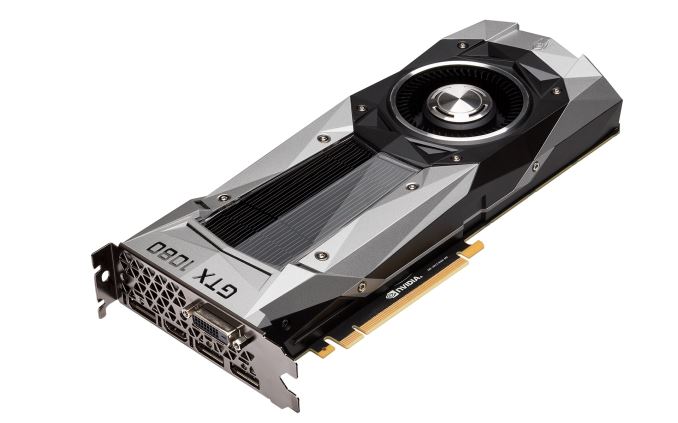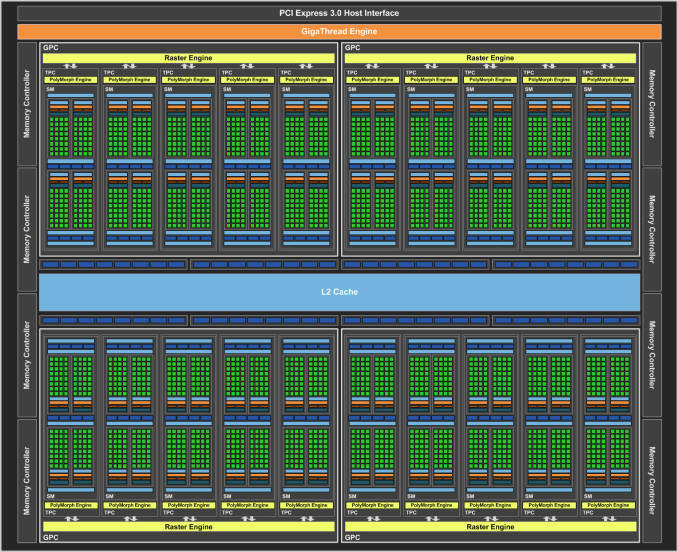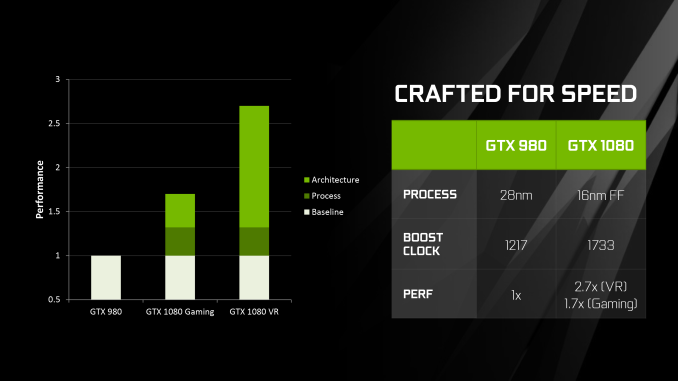The NVIDIA GeForce GTX 1080 Preview: A Look at What's to Come
by Ryan Smith on May 17, 2016 9:00 AM EST
Earlier this month NVIDIA announced their latest generation flagship GeForce card, the GeForce GTX 1080. Based on their new Pascal architecture and built on TSMC’s 16nm FinFET process, the GTX 1080 is being launched as the first 16nm/14nm-based video card, and in time-honored fashion NVIDIA is starting at the high-end. The end result is that the GTX 1080 will be setting the new high mark for single-GPU performance.
Unlike past launches, NVIDIA is stretching out the launch of the GTX 1080 a bit more. After previously announcing it back on May 6th, the company is lifting their performance and architecture embargo today. Gamers however won’t be able to get their hands on the card until the 27th – next Friday – with pre-order sales starting this Friday. It is virtually guaranteed that the first batch of cards will sell out, but potential buyers will have a few days to mull over the data and decide if they want to throw down $699 for one of the first Founders Edition cards.
As for the AnandTech review, as I’ve only had a few days to work on the article, I’m going to hold it back rather than rush it out as a less thorough article. In the meantime however, as I know everyone is eager to see our take on performance, I wanted to take a quick look at the card and the numbers as a preview of what’s to come. Furthermore the entire performance dataset has been made available in the new GPU 2016 section of AnandTech Bench, for anyone who wants to see results at additional resolutions and settings.
Architecture
| NVIDIA GPU Specification Comparison | ||||||
| GTX 1080 | GTX 980 Ti | GTX 980 | GTX 780 | |||
| CUDA Cores | 2560 | 2816 | 2048 | 2304 | ||
| Texture Units | 160 | 176 | 128 | 192 | ||
| ROPs | 64 | 96 | 64 | 48 | ||
| Core Clock | 1607MHz | 1000MHz | 1126MHz | 863MHz | ||
| Boost Clock | 1733MHz | 1075MHz | 1216MHz | 900Mhz | ||
| TFLOPs (FMA) | 9 TFLOPs | 6 TFLOPs | 5 TFLOPs | 4.1 TFLOPs | ||
| Memory Clock | 10Gbps GDDR5X | 7Gbps GDDR5 | 7Gbps GDDR5 | 6Gbps GDDR5 | ||
| Memory Bus Width | 256-bit | 384-bit | 256-bit | 384-bit | ||
| VRAM | 8GB | 6GB | 4GB | 3GB | ||
| FP64 | 1/32 | 1/32 | 1/32 FP32 | 1/24 FP32 | ||
| TDP | 180W | 250W | 165W | 250W | ||
| GPU | GP104 | GM200 | GM204 | GK110 | ||
| Transistor Count | 7.2B | 8B | 5.2B | 7.1B | ||
| Manufacturing Process | TSMC 16nm | TSMC 28nm | TSMC 28nm | TSMC 28nm | ||
| Launch Date | 05/27/2016 | 06/01/2015 | 09/18/2014 | 05/23/2013 | ||
| Launch Price | MSRP: $599 Founders $699 |
$649 | $549 | $649 | ||
While I’ll get into architecture in much greater detail in the full article, at a high level the Pascal architecture (as implemented in GP104) is a mix of old and new; it’s not a revolution, but it’s an important refinement. Maxwell as an architecture was very successful for NVIDIA both at the consumer level and the professional level, and for the consumer iterations of Pascal, NVIDIA has not made any radical changes. The basic throughput of the architecture has not changed – the ALUs, texture units, ROPs, and caches all perform similar to how they did in GM2xx.
Consequently the performance aspects of consumer Pascal – we’ll ignore GP100 for the moment – are pretty easy to understand. NVIDIA’s focus on this generation has been on pouring on the clockspeed to push total compute throughput to 9 TFLOPs, and updating their memory subsystem to feed the beast that is GP104.
On the clockspeed front, a great deal of the gains come from the move to 16nm FinFET. The smaller process allows NVIDIA to design a 7.2B transistor chip at just 314mm2, while the use of FinFET transistors, though ultimately outright necessary for a process this small to avoid debilitating leakage, has a significant benefit to power consumption and the clockspeeds NVIDIA can get away with at practical levels of power consumption. To that end NVIDIA has sort of run with the idea of boosting clockspeeds, and relative to Maxwell they have done additional work at the chip design level to allow for higher clockspeeds at the necessary critical paths. All of this is coupled with energy efficiency optimizations at both the process and architectural level, in order to allow NVIDIA to hit these clockspeeds without blowing GTX 1080’s power budget.
Meanwhile to feed GTX 1080, NVIDIA has made a pair of important changes to improve their effective memory bandwidth. The first of these is the inclusion of faster GDDR5X memory, which as implemented on GTX 1080 is capable of reaching 10Gb/sec/pin, a significant 43% jump in theoretical bandwidth over the 7Gb/sec/pin speeds offered by traditional GDDR5 on last-generation Maxwell products. Coupled with this is the latest iteration of NVIDIA’s delta color compression technology – now on its fourth generation – which sees NVIDIA once again expanding their pattern library to better compress frame buffers and render targets. NVIDIA’s figures put the effective memory bandwidth gain at 20%, or a roughly 17% reduction in memory bandwidth used thanks to the newer compression methods.
As for features included, we’ll touch upon that in a lot more detail in the full review. But while Pascal is not a massive overhaul of NVIDIA’s architecture, it’s not without its own feature additions. Pascal gains the ability to pre-empt graphics operations at the pixel (thread) level and compute operations at the instruction level, allowing for much faster context switching. And on the graphics side of matters, the architecture introduces a new geometry projection ability – Simultaneous Multi-Projection – and as a more minor update, gets bumped up to Conservative Rasterization Tier 2.
Looking at the raw specifications then, GTX 1080 does not disappoint. Though we’re looking at fewer CUDA cores than the GM200 based GTX 980 Ti or Titan, NVIDIA’s significant focus on clockspeed means that GP104’s 2560 CUDA cores are far more performant than a simple core count would suggest. The base clockspeed of 1607MHz is some 42% higher than GTX 980 (and 60% higher than GTX 980 Ti), and the 1733MHz boost clockspeed is a similar gain. On paper, GTX 1080 is set to offer 78% better performance than GTX 980, and 47% better performance than GTX 980 Ti. The real world gains are, of course, not quite this great, but they’re also relatively close to these numbers at times.















262 Comments
View All Comments
Beararam - Tuesday, May 17, 2016 - link
Also, chart shows the 780 having 256 bus width. Is definitely 384.FMinus - Tuesday, May 17, 2016 - link
Can we get a table comparing OCed GTX 980Ti to a stock and OCed GTX 1080 in the final review?strafejumper - Tuesday, May 17, 2016 - link
1 more request - later on update with the new game Overwatch - this comes out May 24yhselp - Tuesday, May 17, 2016 - link
", and in time-honored fashion NVIDIA is starting at the high-end."Come on, at least acknowledge the fact NVIDIA are actually releasing a video card based on medium-sized GPU - the GTX 1080 - and marketing it as a flagship with a price to match, even more.
No need to comment on the fact; no need to criticize NVIDIA for seeking huge margins in the consumer sector ever since Kepler, delaying the real high-end GPU, or any such thing. Just let your readers know the GTX 1080 is based on a mid-sized GPU which is not the GP100 flagship to come from the get go.
A true time-honored fashion for NVIDIA would be releasing a new architecture with the biggest GPU and charging $500 from day one. Something that last happened with Fermi.
nevcairiel - Tuesday, May 17, 2016 - link
It beats every other GPU on the market, if thats not high-end... High-end is a moving target, its whatever is the fastest at the time of writing.Certainly, it could be faster - it always can be. But GP100 just doesn't have the availability yet. They could wait longer and then launch your true "high-end" first, but instead we get new toys sooner, which is always a good thing.
yhselp - Wednesday, May 18, 2016 - link
On the contrary, nowadays we get more performance late, and we pay double for it. We used to get the large-sized GPU first, with a new architecture - just like the GTX 480 - ever since Kepler, however, we've had to wait a year after release. In the meantime, NVIDIA have been charging flagship money for the medium-sized GPU - like the GTX 460 - and releasing the vulgar, super-high margin Titan somewhere in-between. Essentially, by the time the 780 Ti, the 980 Ti, the Titans and even the very cut-down 780 came out, they were already outdated products as far as technology goes, but still carried a premium price tag. Why is that so hard to understand?As far as performance goes - of course a new architecture on a new node will be significantly faster, there's nothing amazing about that. That doesn't mean a video card based on a mid-sized GPU should be marketed as a flagship, as the best thing since sliced bread, and carry such gruesome price premium - $700 for "irresponsible performance" - give me a break! - the only irresponsible thing is blind consumers eating this up. That's why we need competition.
Keep making excuses for big companies, and see how they keep increasing pricing, delaying products, cutting features, and doing whatever the hell they want. Guess who gets screwed as a result of this - that would be you, and me, and every other consumer out there. So keep at it.
yhselp - Wednesday, May 18, 2016 - link
Just to clarify a bit more: going into Kepler NVIDIA were quite nervous about how consumers would react to all this, and although journalists, including Anandtech, noted that the GTX 680 was not a direct successor to the GTX 580, but rather the new GTX 560 Ti, and as such was essentially twice as expensive, it didn't seem to bother consumers perhaps because, as you say - it's so new and fast. Whether it's really because consumers are misinformed, don't care, or a combination of both is irrelevant - it's now history. NVIDIA managed to get away with it. It has been that way ever since. And now, with Pascal, they're looking to expand on it all and charge even higher - up to $150 extra as noted at the end of this article. They might be looking to establish a great premium for overclocking capabilities as well. A sort of Intel K-series, but on top of a product that is already very expensive.The Titan-class cards are just the other side of this story. After a successful GTX 680 launch, NVIDIA decided to try and do the same with the large-sized Kepler GPU. On top of delaying the flagship product - the GK110 - they decided to, again, charge essentially double. And thus the original Titan was born. They were so nervous about it that they decided to enable serious compute performance on it so that if it fails in the consumer sector, it'd sell in the compute world. It outlived their wildest dreams - apparently, people were not only willing to throw money at them, but didn't know any better either. And so we put the writing on the wall, and we've been reaping the "benefits" ever since. It looks like we'll do the same again.
lashek37 - Tuesday, May 17, 2016 - link
I'm selling my 980T.i and buying this beast.anybody on board?😂😉Lolimaster - Tuesday, May 17, 2016 - link
If you got a ti, theres no reason to "upgrade" to this card.Wait Vega or the 1080ti.
Iamthebst87 - Tuesday, May 17, 2016 - link
If you do I'd wait till AIB card become available. The reference 1080 OCs like crap compared to Maxwell. The 980ti reference OC got about 20%-25% performance gain on OC, the 1080 gets about 10%-12%. If you have an AIB 980ti you might even be getting more on the OC. So to sum it up an AIB OC 980ti is only slightly slower 15%-20% than a OC 1080.